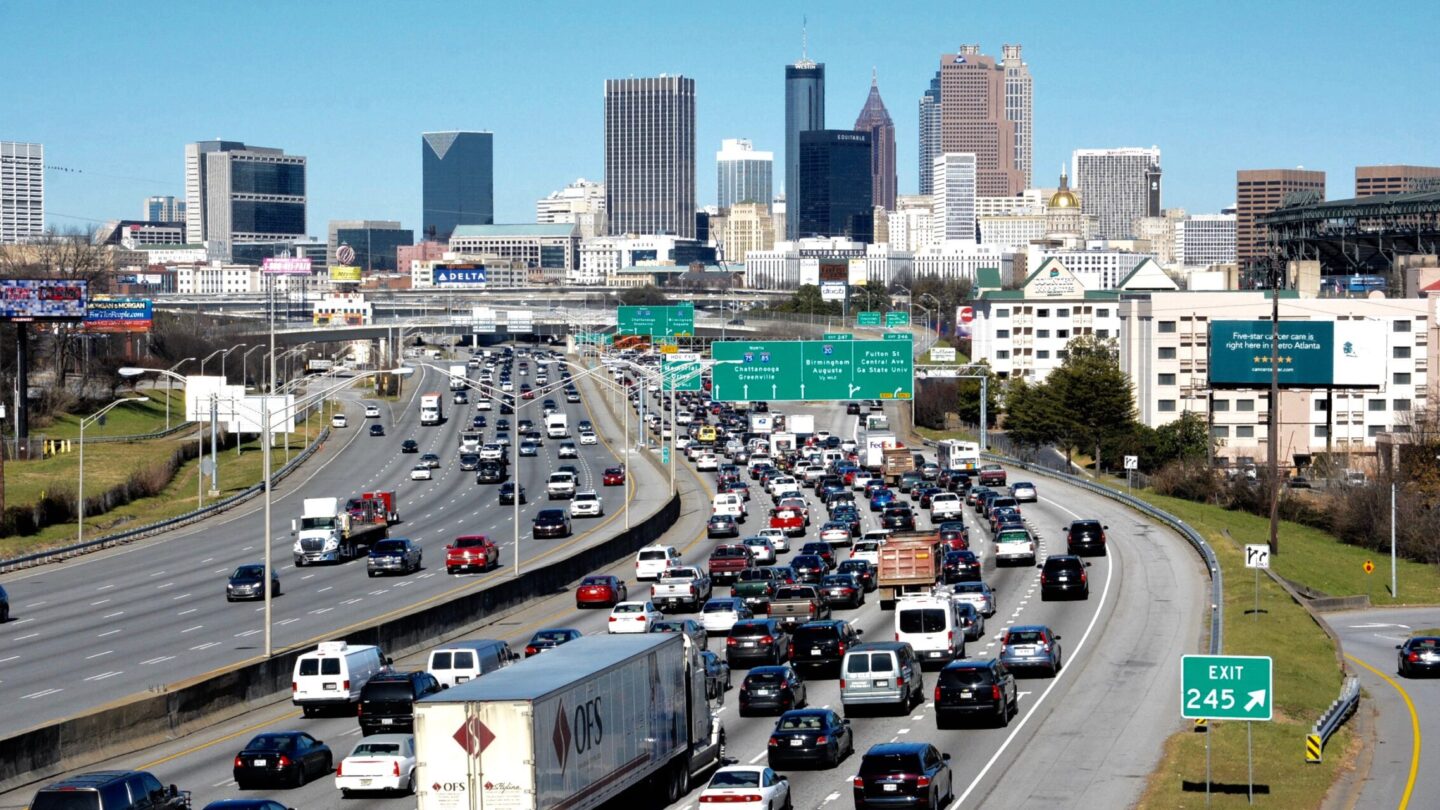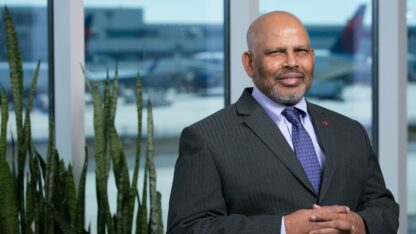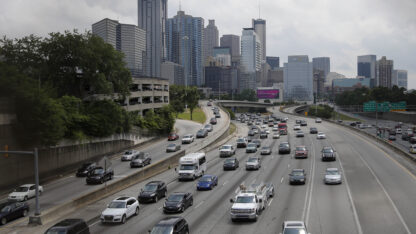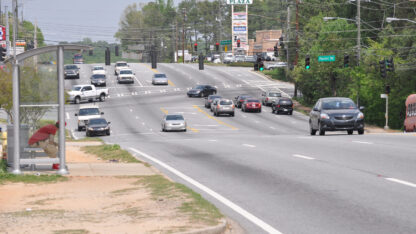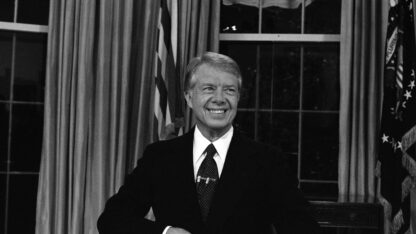Trucker Tim Chelette has been making the same twice-daily drive for 16 years hauling empty whiskey barrels from Louisville, Kentucky, to the Jack Daniels distillery in Tennessee, yet his workday keeps getting longer due to time lost in Nashville traffic.
Although trucks wouldn’t be eligible for the pay-to-use express lanes Republican Gov. Bill Lee is advocating for some of Tennessee’s most-congested highways, Chelette supports them because he thinks enough drivers in the fast-growing state capital would take advantage to benefit everyone.
“They’re going to have to do something,” said Chelette, of Murfreesboro, Tennessee, who gets paid by distance, not time — even when his 245-mile (394-kilometer) return trip to the Lynchburg distillery spikes by an hour or more during afternoon rush. “When I get stuck in traffic, I lose money.”
Unlike traditional toll plazas where every vehicle that passes through pays a standard fee, price-managed lanes allow some drivers to pay up to circumvent congestion — and the fee usually increases as the traffic does.
According to the International Bridge, Tunnel and Turnpike Association (IBTTA), which lobbies on behalf of the projects, 54 of the 89 tolling facilities that opened in the U.S. in the past decade were for price-managed lanes. They can be found across the South in Texas, Florida, Georgia, North Carolina and Virginia, as well as such other places as California, Colorado, Washington and Minnesota.
Opponents call them “Lexus lanes,” implying that only drivers of expensive cars can afford to use them, but Lee prefers another name: “choice lanes.”
“I think (the name) is brilliant. I wish I had invented it,” said Robert Poole, director of transportation policy at the libertarian Reason Foundation and a vocal advocate for price-managed lanes.
The marketing pitch is important, particularly in the conservative South where voters have long resisted anything resembling a tax hike. But with fuel tax revenues and federal infrastructure payments failing to keep up with the need to repair aging roads or add capacity to reduce congestion, the projects are winning favor — even, and perhaps especially, in Republican-led states where “toll” has been considered a four-letter word in more ways than one.
“All you’re doing is allowing those wealthy enough to use those lanes a quicker ride to work,” said Terri Hall, founder and director of Texans for Toll-free Highways. “It’s like a scapegoat for state legislatures to say, ‘We solved the problem.’ No, you kicked the can down the road.”
Supporters counter that the lanes are a way to pay for roads without raising taxes, though they acknowledge they’re sometimes a tricky sell — particularly the public-private partnerships that have funded many of the projects.
“If you have somebody who is anti-tax and pro-free market, they might say it’s a great idea,” said Pat Jones, IBTTA’s executive director and CEO. “Then, if you tell them the company is from Spain or Australia, they’ll say, ‘I don’t want there to be foreigners owning highways.’ You often see opposition to toll facilities before people use them, but once they’re open and people realize they’re getting value … the resistance tends to go down.”
California’s experience with tolling — both traditional plazas and price-managed lanes — has provided fodder for advocates on both sides of the heated debate.
A grand jury in Orange County examined a state agency that was created to build three traditional toll roads. Its report, issued in 2021, found that on one hand, California produced “excellent roads with minimal tax dollars.” But on the other, the jurors found ballooning debt and the need to change the initial plans amid financial downturns meant that drivers are on pace to shell out $28 billion by 2053 for roads that cost a tenth of that to build.
The nation’s first price-managed lane opened in 1995 in Orange County, using a public-private partnership to fund it. Poole, who advised on the project and still calls it a model for others, said officials agreed not to add free lanes on the corridor for 35 years. Surging growth ultimately made that impossible, so the county terminated the contract and paid the company for its lost revenue. New bonds were issued, and the tolls had to stay in place to pay for them.
“These agencies often become self-fulfilling entities,” said Jay Beeber, director of public policy for the National Motorists Association, which advocates for drivers’ rights. “They have huge organizations with lots of staff members, lots of salaries, huge pensions from the government, and they want to stay in business forever. Nobody wants to legislate themselves out of a job.”
Lee is seeking legislative support to authorize a public-private partnership for the project in Tennessee — one of 14 states that don’t have tolls on any roads.
Republican state Sen. Frank Niceley said he expects Lee will get enough votes to pass the plan, but he strongly opposes it — even pointing out that fascist Italian dictator Benito Mussolini liked public-private partnerships, too.
“We’re not really giving these things to the private sector,” Niceley said. “We’re kind of co-signing the note. And most people who co-sign the note end up paying the note.”
The governor’s administration brushes off such criticism. Will Reid, chief engineer and deputy commissioner at the Tennessee Department of Transportation, said the state is uniquely positioned to establish a partnership that avoids the financial pitfalls seen in California and elsewhere.
“We’re one of six no-debt states,” Reid said. “We own every piece of pavement. We own every bridge. We have a strong belief in paying as we go, and paying for the things we decide to build.”
Mark Burris, professor of civil and environmental engineering at Texas A&M University, researched public sentiment for price-managed lanes in four metro areas: Los Angeles, Dallas, Miami and the Virginia suburbs of Washington, D.C. His review found widespread support from drivers in those areas, with more than three-quarters of those surveyed saying they wanted to see more price-managed lanes open.
Some of the paid express lanes in Texas have allowed speed limits as much as 10 mph higher than general-purpose lanes, and Hall, with Texans for Toll-free Highways, said the fee can rise to $3 a mile when traffic is busiest. She argues that’s a regressive double-tax that doesn’t alleviate congestion nearly as much as building additional free lanes would — something she contends the state can afford.
Texas also proves how fleeting the support for these projects can be — even with the same party in control. Former Gov. Rick Perry advocated for price-managed lanes, but his successor, fellow Republican Greg Abbott, has backed a moratorium on new tolls.
“Fifteen years ago it was all the rage,” Mark Muriello, IBTTA’s director of public policy and government affairs, said of the appetite for the projects in Texas. “The politics tend to change. Nothing stays still.”
It typically takes 15 years in the U.S. for a road project to open after winning approval, though Tennessee officials are determined to cut that in half. Considering a recent study showing a $34 billion need, Reid — the state transportation official — acknowledges the clock is ticking.
“As far as whether it works 10, 20, 30 years from now, the proof will be in the pudding,” Reid said. “But one thing is certain — in order to keep pace with the demands on our infrastructure in Tennessee, we’re going to have to find a different way to generate revenue.”
